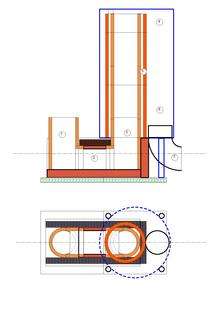Rocket mass heater
A rocket mass heater (also termed rocket stove mass heater) is a space heating system developed from the rocket stove, a type of efficient wood-burning stove, and the masonry heater. Its fundamental characteristics are an insulated combustion chamber where fuel (generally wood) is burned with high efficiency at extremely high temperatures, and a large thermal mass in contact with the exhaust gases which absorbs most of the generated heat before the gases are released to the atmosphere.[1] According to various reports a rocket mass heater can reduce fuel consumption by 80 - 90% compared to "conventional" stoves.

An internal vertical insulated chimney, the combustion chamber, ensures an efficient high-temperature burn and creates enough draft to push exhaust gases through the rest of the system. Flue gases are cooled to a relatively low temperature within the thermal store, approximately 50 °C (122 °F), and in some designs steam within these gases condenses into liquid, releasing the associated latent heat of condensation which further increases the efficiency in the manner of a condensing (gas) boiler.[2]
History
The rocket (cooking) stove was developed by the Aprovecho Institute, and described in 1982.[3] A rocket stove is a cooking appliance optimized to provide relatively high heat utilization and low emissions.
The first prototype was built in the 1980s. Although in some sense simply a variation on a masonry heater, most rocket mass heaters are distinct in producing immediate radiant heat (from the metal "burn" barrel), in being constructed of much cheaper materials (usually a cob mass, 55 gallon steel drum, and small brick firebox), and in requiring less robust a base to be constructed on, since a rocket mass heater's weight is distributed over a larger area. Moreover, masonry heaters have been used since pre-historic times and have evolved into various designs in Europe, Russia, and China. The key principle is the incorporation of a large thermal mass built of masonry which absorbs heat from exhausting combustion products directed in a sinuous path through channels embedded in the masonry.[4]
Designs

In the earliest and most popular form, wood is gravity-fed into a "J-shaped" combustion chamber, from where the hot gases enter a heavily insulated fire-brick or ceramic refractory vertical secondary combustion chamber, the exhaust from which then passes along horizontal metal ducting embedded within a massive cob thermal store. The thermal store is large enough to retain heat for many hours and may form part of the structure of the building. They have proved to be popular with natural buildings and within permaculture designs; they are normally self-built and are not yet recognized by all building codes which regulate the design and construction of heating systems within buildings.
More recent alternate developments have instituted a batch-fed horizontal firebox which feeds into the vertical heat riser or secondary combustion chamber. This type is termed the "batch box rocket" and is described on Peter van den Berg's website. Also, the horizontal duct flow through the mass may be replaced by a massive "bell" of larger cross section where the hot gases slow and stratify and the cooled gases exit near the bottom as in some masonry heaters. These developments may be used in different combinations in specific instances.
Components
This section describes the components of a J-style RMH.
Combustion unit
The fuel feed receives fuel vertically.[5]
Heat exchange mass
The thermal mass which encloses the exhaust duct and absorbs heat from the hot combustion gases is normally made of “cob,” which is a clay and sand mixture reinforced with straw. The thermal mass is often sculpted into a bench which becomes an integral architectural feature of the home, radiating thermal energy into the space for more than 24 hours after the wood fuel is exhausted.[4]
Issues
- Three rocket mass stoves or stove designs have been safety certified. The Liberator Rocket Heater, tested to Underwriters Laboratories-1482 safety standard, which is currently on the market, the Eireco Rocket Stove certified in Europe to BS and EN 13240, and Rocket Heater Gamera certified to EN 13240. These stoves are also currently on the market.
- Stoves are often self-built to varying dimensions to suit the location and requirements, using a variety of materials.
- Improper lighting of the fire may produce smoke that is often not drawn into the exhaust system until the burning chamber is heated and drawing air.
- A common problem with some designs is "smoke-back", where smoke from the fire is released back into the interior rather than outside. Smoke-back could indicate a serious risk of carbon monoxide poisoning. This issue could be a result of poor individual stove design, or inadequate preheating of the exhaust tube, resulting in inefficient draft to pull the smoke through.
- In some designs, exhaust gases contain so little heat that chimney draft becomes an issue. Conventional chimneys may not be suitable for discharge without additional energy inputs.[6] The cool heater exhaust leaves open the question of chimney deposits such as creosote, and reliable measures for cleaning such combustible deposits to reduce the risk of chimney fires. This can be a problem if the rocket mass heater is built incorrectly; like a masonry heater, the properly built rocket mass heater burns all combustibles - including creosote - in the burn chamber and barrel.
- Horizontal exhaust vents may not be compatible with local building codes. The only advantage of the horizontal exhaust, besides usually reducing the amount of chimney pipe needed, is that remarkably high efficiency can potentially be achieved, but if so, the corrosive condensate resulting from the near-total extraction of the exhaust gases' heat must be allowed to flow out the slightly downward sloping stovepipe.
Notes
- Evans & Jackson, Rocket Mass Heaters, pp. 5, 20
- Wheaton, "rocket stove mass heater"
- Aprovecho, "Whole stoves"
- Schumack, Mark (2016-01-25). "A computational model for a rocket mass heater". Applied Thermal Engineering. 93: 763–778. doi:10.1016/j.applthermaleng.2015.10.035. ISSN 1359-4311.
- Wisner & Wisner, The rocket mass heater builder's guide, p2
- Evans & Jackson, Rocket Mass Heaters, p. 93
References
- Evans, Ianto & Jackson, Leslie (2004-2014). Rocket Mass Heaters, Third Edition. "www.rocketstoves.com." Cob Cottage Co., 2014. ISBN 0-9663738-4-7.
- Wheaton, Paul. "rocket stove mass heater" RichSoil.com. Retrieved July 15, 2012.
- "Whole stoves". Aprovecho. Retrieved 2009-04-13.
- "Book Review – Rocket Mass Heaters – Ianto Evans & Leslie Jackson". Retrieved 2011-04-30.
- Mackay, Mary (November 10, 2012), "Stove Really Takes Off", Times Colonist, retrieved June 12, 2014
- Erica Wisner; Ernie Wisner (2016). The rocket mass heater builder's guide : complete step-by-step construction, maintenance and troubleshooting. New Society Publishers. ISBN 9781550926163.
- Peter van den Berg. "Batchrocket.eu". batchrocket.eu.
External links
| Wikimedia Commons has media related to Rocket mass heater. |
- Ernie and Erica Wisner's site
- Rocket Stove Mass Heater Tour and How-To - includes video samples of 12 heaters and a 10-minute how-to